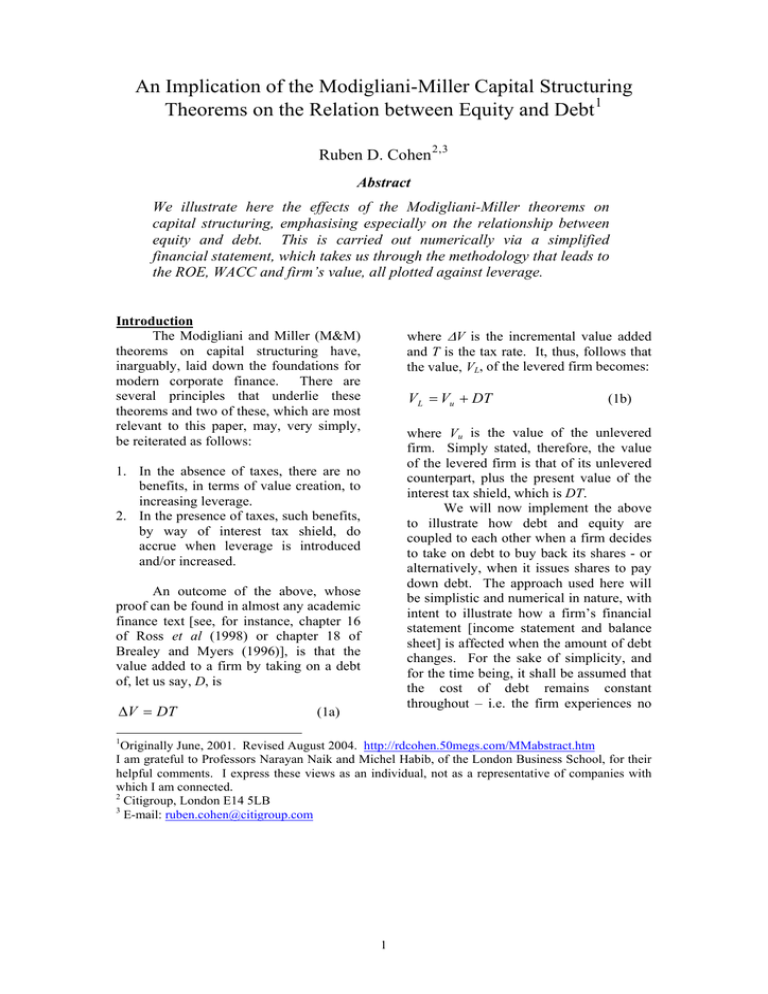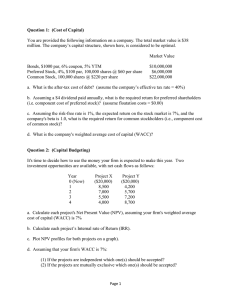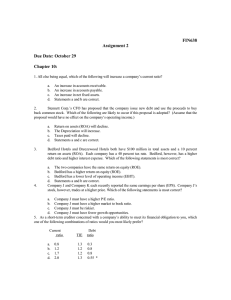An Implication of the Modigliani-Miller Capital Structuring
advertisement

An Implication of the Modigliani-Miller Capital Structuring Theorems on the Relation between Equity and Debt1 Ruben D. Cohen 2,3 Abstract We illustrate here the effects of the Modigliani-Miller theorems on capital structuring, emphasising especially on the relationship between equity and debt. This is carried out numerically via a simplified financial statement, which takes us through the methodology that leads to the ROE, WACC and firm’s value, all plotted against leverage. Introduction The Modigliani and Miller (M&M) theorems on capital structuring have, inarguably, laid down the foundations for modern corporate finance. There are several principles that underlie these theorems and two of these, which are most relevant to this paper, may, very simply, be reiterated as follows: where ΔV is the incremental value added and T is the tax rate. It, thus, follows that the value, VL, of the levered firm becomes: V L = Vu + DT where Vu is the value of the unlevered firm. Simply stated, therefore, the value of the levered firm is that of its unlevered counterpart, plus the present value of the interest tax shield, which is DT. We will now implement the above to illustrate how debt and equity are coupled to each other when a firm decides to take on debt to buy back its shares - or alternatively, when it issues shares to pay down debt. The approach used here will be simplistic and numerical in nature, with intent to illustrate how a firm’s financial statement [income statement and balance sheet] is affected when the amount of debt changes. For the sake of simplicity, and for the time being, it shall be assumed that the cost of debt remains constant throughout – i.e. the firm experiences no 1. In the absence of taxes, there are no benefits, in terms of value creation, to increasing leverage. 2. In the presence of taxes, such benefits, by way of interest tax shield, do accrue when leverage is introduced and/or increased. An outcome of the above, whose proof can be found in almost any academic finance text [see, for instance, chapter 16 of Ross et al (1998) or chapter 18 of Brealey and Myers (1996)], is that the value added to a firm by taking on a debt of, let us say, D, is ΔV = DT (1b) (1a) 1 Originally June, 2001. Revised August 2004. http://rdcohen.50megs.com/MMabstract.htm I am grateful to Professors Narayan Naik and Michel Habib, of the London Business School, for their helpful comments. I express these views as an individual, not as a representative of companies with which I am connected. 2 Citigroup, London E14 5LB 3 E-mail: ruben.cohen@citigroup.com 1 default risk as it raises its leverage. Including these effects is quite trivial, but shall not be pursued at this point. A companion paper, instead, focuses on it (Cohen, 2004). 3. Analysis We plan to investigate here the evolution of a simple firm, which initially has all its assets backed by equity 4 . The firm then issues debt to buy back shares and, in the process, its value will rise, owing to debt-related tax benefits. We shall consider three scenarios, whereby: 1. The firm has an initial asset base [value] of 100 and no debt [Scenario 1]. The equity, E, of this firm is, therefore, 100 and should, thus, represent the unlevered firm’s value, Vu. We further assume that this firm has an “expected” EBIT 5 , of 20 and pays tax and interest at constant rates of 40% and 5%, respectively. Subsequently, this firm will have a financial statement similar to that shown in Figure 1. 2. In Scenario II, the firm takes on a debt, D, of 50 to buy back some of its shares. One of M&M’s outcomes, which is Equation 1, states that the firm’s value should increase by DT. According to our numbers, this equates to 20, which when added to the asset base, raises it from 100 to 120. It also follows that the firm must pay an interest of 2.5 [= 50 x 5%]. The consequence of the above is a financial statement that resembles the one shown in Figure 2. It is important to note here that the capacity to buy back shares is only 30, as the remaining 20 of the debt of 50 must be added to the asset base in the form of cash, etc. 6, 7 In Scenario III, the firm takes on additional debt of 30 on top of the 50 in Scenario II. The total debt of 80 will thus create a tax-benefit-related value of 32 over the initial base case of 100 in Scenario I. As shown in Figure 3, therefore, the firm’s value will total 132, with a debt of 80 and a balancing equity of 52. The firm will also have to pay interest of 4 [= 5% x 80]. Discussion Let us now move on and discuss the consequences of debt on the financial statement, as well as on a pair of relevant ratios, namely the return on [or cost of] 8 equity, ROE, and the weighted average cost of capital, WACC. Traditionally, these are defined as: WACC ≡ expected EBIT × [1 − tax rate ] debt + equity (2a) and ROE ≡ expected profit equity = [ expected EBIT − interest ] × [1 − tax rate ] equity (2b) For convenience, we have collated the results of the 3 scenarios in Table 1 and produced Figures 4 and 5, which, respectively, portray E versus D, as well as WACC and ROE against leverage, D/E. 4 For the time being, and for simplicity, we assume that the market and book equities are one and the same. In reality, however, the two are different and should be treated differently. This argument will be left out of this note, as it is out of its scope. 5 The “expected” EBIT is that which reproduces the stock’s total rate of return. It, thus, incorporates, along with the net profits, interest paid and taxes, the beta of the stock, the risk-free rate, as well as the market’s risk premium. See Cohen (2004) for the analytical formulation. 6 The increase in a firm’s value due to the interest tax shield is not goodwill. In fact, goodwill plays no part in M&M’s theorem. 7 An important assumption that will be carried on forward from here, and which underlies the M&M methodology, is that the EBIT remains constant while the value of the firm varies with the exchange of debt and equity. 8 Under the idealised assumptions stated in Footnotes 4 and 5, the cost of equity becomes equivalent to the return on equity. 2 Looking at Figure 4, we observe that equity, E, falls linearly with debt, D. This, of course, is due to share buyback. However, we also note that the relation between the two is E + 0.6 D = 100 I, never the less, states that with no taxes, there are no debt-related tax benefits, and with no such benefits [assuming everything else remains constant] there is no optimal capital structure. With no optimal capital structure, therefore, one could only conclude that the whole notion [based on the contention that E + D = constant] of trying to locate the optimal capital structure becomes selfcontradictory and, thus, meaningless! And last, but not least, what would happen, in the mathematical sense, if E + D = constant were to be used instead of Equation 4? Ignoring the details, which are out of the scope of this work, each and every WACC versus D/E point that is derived in this way will lie on a different WACC curve. (3) which, more generally, formulates into: E + (1 − T ) D = constant (4) where the constant is the unlevered firm’s value, Vu, as introduced in Equation 1b. Also, plots of WACC and ROE, both of which are presented in Figure 5, appear to behave as theory dictates, with ROE rising in a straight-line fashion and WACC falling non-linearly with D/E. References General Remarks We now ask why bother with all this? The reason is that credit analysis and optimisation of capital structure constitute a major segment in many banking activities. These activities cover, to name just a few, corporate finance, investment, financial analysis and plain, general research. Nevertheless, it is noted that in a large number of these studies, the capital, i.e. the sum, E + D, is taken as constant. In reference to Equation 4, however, we observe that this translates into the special case of no taxes - i.e. let T = 0 in Equation 4 and we recover E + D = constant . M&M’s Proposition Brealey, R.A. and Myers, S.C., Principles of Corporate Finance, 5th Ed., McGraw-Hill, 1996. Cohen, R.D., “An Analytical Process for Generating the WACC Curve and Locating the Optimal Capital Structure,” Wilmott Magazine, November 2004 [Download]. Ross, S.A., R.W. Westerfield and B.D. Jordan, Fundamentals of Corporate Finance, 4th Ed., McGraw-Hill, 1998. 3 Scenario I Scenario II Scenario III D 0 50 80 E 100 70 52 D/E 0.00 0.71 1.54 ROE 12.0% 15.0% 18.5% WACC 12.0% 10.0% 9.1% Table 1 – The results of the three different scenarios depicted in Figures 1-3. Income Statement Expected EBIT 20 Interest (at 5%) 0 EBT 20 Tax (at 40%) 8 Expected profit 12 Balance Sheet Assets Debt Equity Total Debt & Equity 100 0 100 100 Relevant Ratios D/E ROE WACC 0.00 12.0% 12.0% Figure 1 – Scenario I’s financial statement, where the firm has no debt. Income Statement Expected EBIT 20 Interest (at 5%) 2.5 EBT 17.5 Tax (at 40%) 7 Expected profit 10.5 Balance Sheet Assets Debt Equity Total Debt & Equity 120 50 70 120 Relevant Ratios D/E ROE WACC 0.71 15.0% 10.0% Figure 2 – Scenario II’s statement, where the firm takes on a debt of 50 to buy back shares. 4 Income Statement Expected EBIT 20 Interest (at 5%) 4 EBT 16 Tax (at 40%) 6.4 Expected profit 9.6 Balance Sheet Assets Debt Equity Total Debt & Equity 132 80 52 132 Relevant Ratios D/E ROE WACC 1.54 18.5% 9.1% Figure 3 – Scenario III’s statement, where the firm takes on more debt to buy back shares. 120 100 Equity, E 80 60 40 Debt, D 20 0 20 40 60 80 100 Figure 4 – The relationship between debt and equity. The numbers are taken from Figures 1-3 22% WACC ROE 19% 16% 13% 10% Leverage, D/E 7% 0.0 0.5 1.0 1.5 2.0 Figure 5 – The behaviour of WACC and ROE plotted against leverage, D/E. 5






